 Do you feel like food prices are increasing every time you go to the store or eat out?
Do you feel like food prices are increasing every time you go to the store or eat out?
It’s not just a feeling – it’s reality!
In just the last 12 months, food prices have increased more than any time since 1981! The biggest increases have been seen in meat, poultry, fish and eggs, which are up over 13% since this time last year. Dairy and other food categories are up anywhere from 7% to 10%.
And, if you stop somewhere to grab a sandwich while you are out, you have likely paid between 14% and 18% more than you did a year ago. We have personally seen the cost of some grocery store items increase over 50%!
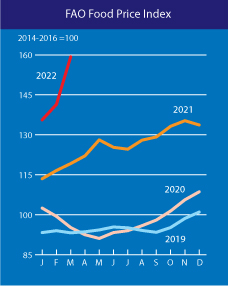 If that wasn’t bad enough, economists from the USDA are estimating further price increases in 2022…UGH!
If that wasn’t bad enough, economists from the USDA are estimating further price increases in 2022…UGH!
- For store-bought groceries, they are estimating additional increases of 3% to 4% this year (led by poultry, fats and oils at 6% to 7%).
- Interestingly, they are estimating fresh vegetable price increases of 1% to 2%.
- For food away from home, they are estimating 5.5% to 6.5% increases in 2022.
Why is this happening?
There are several factors contributing to these price increases including supply chain disruptions, labor shortages, higher wage rates, higher fuel costs (making transportation more expensive) and weather events. Even the tragic events in Ukraine are affecting certain food prices. There are so many uncertainties, it is impossible for anyone to know where food prices will go from here. Although, one thing seems pretty clear – higher food prices are here to stay.
Have we bummed you out now?! We know it is very discouraging, but we are here to help!
The good news is there are many strategies you can use to reduce the effects of increasing food prices!
Here are just a few:
- Eat more plants. Given the changes in food prices, eating more of these foods – and less meat, fish, eggs and dairy – can be a huge win for both your health AND your bank account! Take advantage of all the resources at Eat REAL America to transform your veggies, fruits, nuts, seeds, beans, legumes and whole grains into flavor-loaded meals! You don’t have to give up meat, fish, eggs and dairy – just change the proportions and make plants the focus of your meals.

- Eat in-season. In-season fruits and vegetables will always cost less than those that are out of season. In the next few weeks, you will probably notice great deals on asparagus, radishes, rhubarb, spring onions and maybe even strawberries. Yes, you can buy peaches and watermelon at the store right now, but trust us and don’t do it! They will cost at least $1/pound more than when they are in-season later in the summer (plus, they just won’t taste great right now). Just like asparagus will cost way more if you try to buy it in the fall vs. enjoying it now.
- Farmers’ market. Shopping the farmers’ market is another way to get in-season produce at a great price. Plus, you are getting the best possible nutrition and taste and supporting your local producers. Farmers’ market prices have likely not increased as much as grocery store prices because they aren’t having to deal with the same labor shortages and transportation costs. And it’s not just the produce – you can now get even better deals on eggs, beef, poultry and other foods compared to increasing grocery store prices.
 Stock up on discounted and sale items. Many stores will have clearance sections or have foods randomly marked down (sometimes 50% or more) throughout the store. Often, these are foods approaching their “best by” dates — they are typically perfectly fine to eat, especially if you are using them in the next day or two, or if you can freeze them for future use. Personally, our pantry and freezer are loaded with these “clearance” reduced stickers. You can also find great deals by monitoring weekly ads and using online coupons from your local stores.
Stock up on discounted and sale items. Many stores will have clearance sections or have foods randomly marked down (sometimes 50% or more) throughout the store. Often, these are foods approaching their “best by” dates — they are typically perfectly fine to eat, especially if you are using them in the next day or two, or if you can freeze them for future use. Personally, our pantry and freezer are loaded with these “clearance” reduced stickers. You can also find great deals by monitoring weekly ads and using online coupons from your local stores.- Buy in bulk! For items with a longer shelf life (like whole grains, pasta and canned veggies) and frozen foods, you can buy larger quantities to get discounts. We often buy nuts (almonds, pecans and walnuts), maple syrup, almond butter, and other foods at our local wholesale clubs. We also use this strategy at the farmers’ market – for example we will buy several pounds of grass-fed beef and keep it in the freezer. And we buy large quantities of blueberries, corn on the cob, and Hatch chilies when they are in season and freeze them to enjoy throughout the year.
 Use the freezer! If you find great discounts or sales, stock up and use your freezer. Breads, fruits and berries, nuts, meats and firm cheeses are just a few examples of foods that freeze great. There are some foods that don’t freeze very well, including high moisture vegetables (like lettuce, cucumbers and tomatoes).
Use the freezer! If you find great discounts or sales, stock up and use your freezer. Breads, fruits and berries, nuts, meats and firm cheeses are just a few examples of foods that freeze great. There are some foods that don’t freeze very well, including high moisture vegetables (like lettuce, cucumbers and tomatoes).- Eat at home. Cooking and eating at home will always be cheaper than eating out. This study found that, on average, it is 5 times more expensive to order delivery from a restaurant than to cook at home. They also found that meal kit services are almost 3 times more expensive than cooking from scratch.
- Love your leftovers! Remember, leftovers don’t have to be boring…we like to think of them as planned-overs! With just a little thought, you can transform your leftover meals into entirely new meals and even those who think they don’t like leftovers will love them! We have many ideas for these 2-for-1 meals and of course, don’t forget about enjoying your leftovers for breakfast – with an egg on top!
- Substitute less expensive ingredients. It is possible to save a ton of money by eating less meat and eating more beans, lentils and legumes. We know, you may be thinking, “but those are boring and my family will never eat them.” We have all kinds of ideas that are NOT boring…have you tried our Stove Top Baked Beans, Lentil Sloppy Joes, or Southwest Stuffed Sweet Potato?! You can also use rice instead of pasta, or substitute in-season veggies for your noodles (things like spaghetti squash or spiralized zucchini).
- Grow your own. Whether you grow an entire garden or just grow some herbs on the patio, this is a great money-saver. A couple of basil plants can produce fresh basil all summer long (vs. paying $3 or more each time you buy fresh basil from the store).
 Ugly produce. Whether at the store or the farmers’ market, seek out the slightly bruised, beaten and disfigured produce! You can typically get these at a significant discount and don’t have to sacrifice flavor. Of course, you may have to cut off a bad spot or two, but don’t let that discourage you. At the farmers’ market, we regularly buy “ugly” tomatoes that are 1/3 of the price of the “pretty” ones! And, we got a great deal on asparagus that had been damaged a couple days prior by a hail storm. It had taken a beating, but the taste and nutrition were still just as good as the pretty ones that survived the storm!
Ugly produce. Whether at the store or the farmers’ market, seek out the slightly bruised, beaten and disfigured produce! You can typically get these at a significant discount and don’t have to sacrifice flavor. Of course, you may have to cut off a bad spot or two, but don’t let that discourage you. At the farmers’ market, we regularly buy “ugly” tomatoes that are 1/3 of the price of the “pretty” ones! And, we got a great deal on asparagus that had been damaged a couple days prior by a hail storm. It had taken a beating, but the taste and nutrition were still just as good as the pretty ones that survived the storm!- Roast it! Grill it! Stir-fry it! If you have vegetables starting to go bad, don’t throw them out! Instead, roast them in the oven, cook them on the grill, or toss them in a stir-fry. It’s as easy as seasoning them with olive oil, salt and pepper, or take them to the next level with our GO-TO seasoning or your favorite spice combination. If you have tomatoes screaming to be used, roast them in the oven or whip up a batch of fresh salsa. You will never have food waste again!
- Make your own dressings, drizzles and sauces. It can be as simple as the 2-1-1 or you can make one of our 50 favorite dressings. Simple, delicious and affordable!
 Don’t always pay more for name brands. There are some name brands that provide higher quality, but most of the time store brands provide the same, or sometimes even better, quality at a lower price point. Often, the same companies are making the name brands AND the store brands. Just remember to read the ingredients! While the store brands often have similar ingredients to the name brands, they can sometimes contain additional additives, preservatives, sodium or sugar.
Don’t always pay more for name brands. There are some name brands that provide higher quality, but most of the time store brands provide the same, or sometimes even better, quality at a lower price point. Often, the same companies are making the name brands AND the store brands. Just remember to read the ingredients! While the store brands often have similar ingredients to the name brands, they can sometimes contain additional additives, preservatives, sodium or sugar.- Have a plan! Without a plan, you will probably buy more food than you need when you hit the store (including those impulse purchases). Plus, when you are ready to think about dinner at 5 PM and don’t have a plan, it can very tempting to hit the drive-through, order take-out or delivery, or throw a frozen pizza in the oven. A meal planning calendar like this one can help plan out your meals and snacks for the week.
We want to help you continue to be inspired to enjoy REAL food and not feel like you are breaking the bank!
Do you have strategies you have found helpful?
Please share with us!
FAO Food Price Index graph comes from April 8, 2002 release found here.



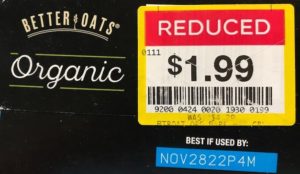
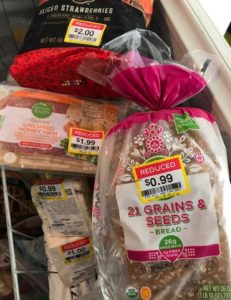
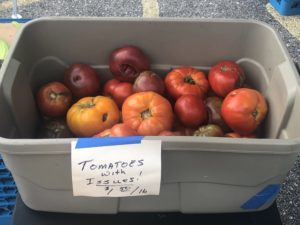
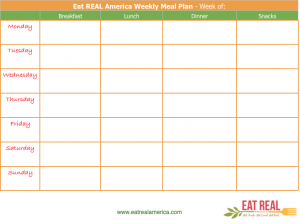
Great ideas and reminders…and links!! Thank you!!
You are so welcome – happy this helps!
Great information. Thanks for sharing.
Thank you for the feedback! We are glad this was helpful!
Every time I see a news story about the increasing costs of meat, eggs, and dairy, I think, “It’s a great time to be a vegan!” Thanks for sharing these ideas!
Soft tomatoes can be cut up and added to pasta sauce. They freeze well, too, as long as you’re going to cook them. I grow extra tomatoes to freeze and don’t have to buy canned until spring.
Making Tuscan Bean Soup for lunch today. We love soups any time of year and meatless soups really help stretch the food budget. Thanks for your timely tips during yet another difficult time.
I buy a couple of large chickens to roast off as it is much cheaper whole. Pull all the meat and use my food saver to portion to hold in the freezer. It’s all ready to go for enchiladas, soups, or salad. Saves on time and cost.
Brilliant tip – we love freezing our Seasoned Slow Cooker Chicken for the exact same reason! Thank you!